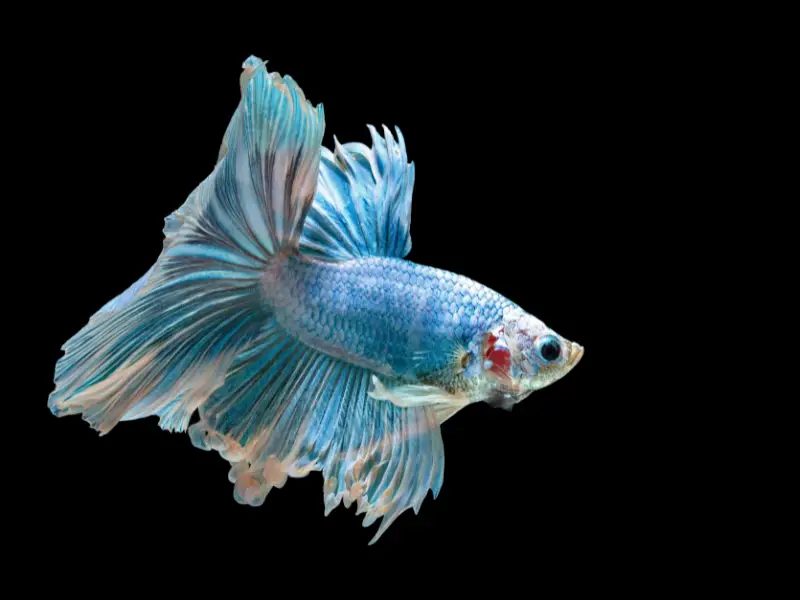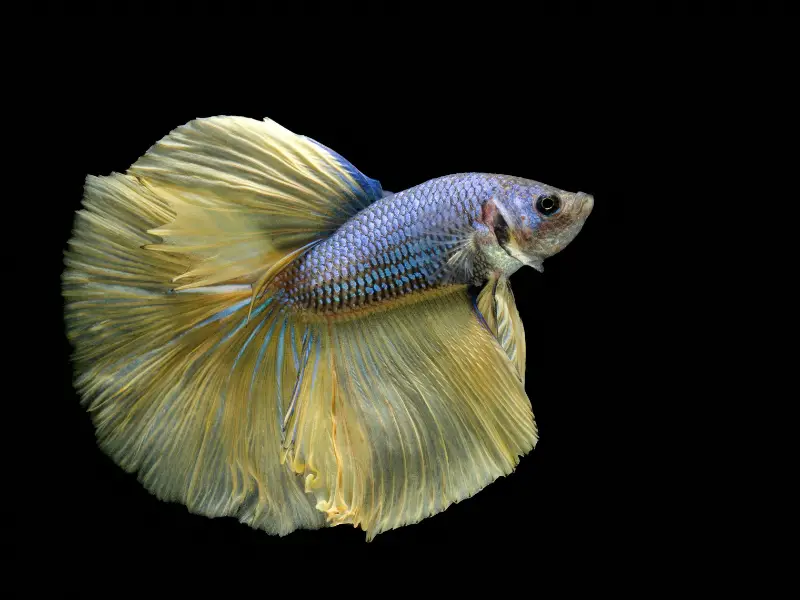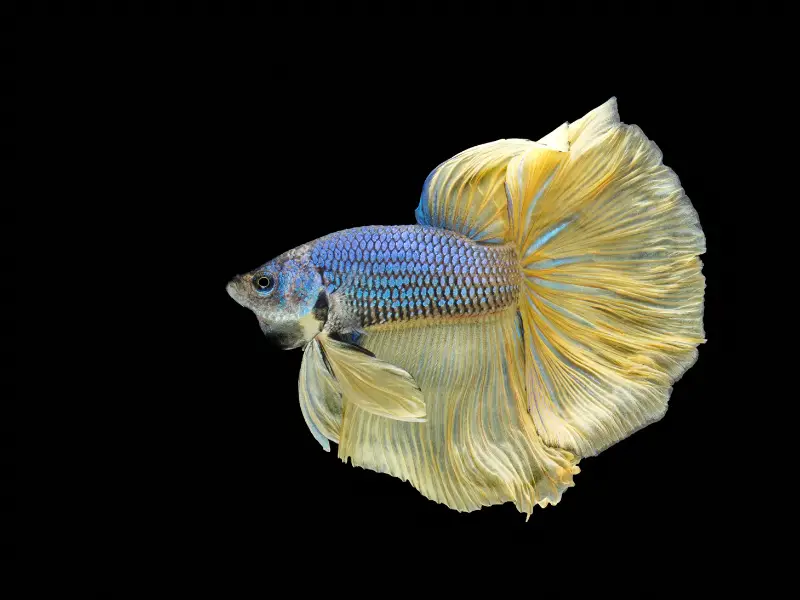The Twintail Halfmoon Betta is a popular freshwater fish known for its vibrant colors and unique appearance. This species of fish is native to Thailand and is commonly found in the waters of Southeast Asia. The Twintail Halfmoon Betta is a member of the Betta family, which is known for its aggressive behavior and territorial nature.
The Twintail Halfmoon Betta is a small fish, typically growing to a length of around 2 inches. It is known for its long, flowing fins and vibrant colors, which can range from bright reds and blues to more muted greens and yellows. This fish is a popular choice for aquarium enthusiasts due to its striking appearance and unique personality.
Overall, the Twintail Halfmoon Betta is a fascinating species of fish that is sure to capture the attention of anyone who sees it. Whether you are a seasoned aquarium enthusiast or simply looking for a unique and beautiful pet, the Twintail Halfmoon Betta is a great choice.
Overview of Twintail Halfmoon Betta
Twintail Halfmoon Betta, also known as Double Tail Halfmoon Betta, is a popular and unique breed of Betta fish. Unlike other Betta fish, Twintail Halfmoon Betta has a split tail that makes it look like it has two tails. This trait is a result of selective breeding, and it is highly valued by Betta fish enthusiasts.
Twintail Halfmoon Betta is a small and colorful fish that can grow up to 3 inches in length. It has a vibrant and iridescent body that can be blue, red, green, purple, or a combination of these colors. Its fins are also colorful and can have intricate patterns and designs.
Twintail Halfmoon Betta is a peaceful fish that can be kept in a community tank with other non-aggressive fish. However, it is important to note that male Betta fish can be territorial and aggressive toward other male Betta fish. Therefore, it is recommended to keep only one male Betta fish in a tank.
Twintail Halfmoon Betta is an easy-to-care-for fish that requires a well-maintained tank with clean water, proper filtration, and regular feeding. It is a carnivorous fish that feeds on live or frozen food such as brine shrimp, bloodworms, and daphnia.
Overall, Twintail Halfmoon Betta is a unique and fascinating fish that can make a great addition to any aquarium. Its vibrant colors and split tail make it a popular choice among Betta fish enthusiasts.
Physical Characteristics

Color Variations
Twintail halfmoon bettas are known for their vibrant and diverse colors. They are available in a wide range of hues, including red, blue, green, yellow, orange, and purple. Some of the most popular color variations include:
- Solid color: Betta fish with a single, solid color are the most common.
- Bi-color: Betta fish with two distinct colors are known as bi-color bettas.
- Marble: Betta fish with a marbled pattern has a mix of different colors and patterns on their scales.
- Butterfly: Betta fish with a butterfly pattern have a solid color on their body and a contrasting color on their fins.
Size and Shape
Twintail halfmoon bettas are known for their unique and distinctive shape. They have a large, fan-shaped tail that splits into two distinct lobes, giving them their name. In addition to their tails, they also have long, flowing fins that extend from their dorsal and anal fins.
On average, twin-tail halfmoon bettas grow to be about 2.5 inches in length. However, some can grow up to 3 inches in length. They have a streamlined body shape that is designed for swift swimming and maneuvering through the water.
Overall, twin-tail halfmoon bettas are a beautiful and unique addition to any aquarium. Their vibrant colors and distinctive shape make them a popular choice among fish enthusiasts.
Habitat Requirements
The Twintail Halfmoon Betta is a freshwater fish that originates from the rice paddies, swamps, and slow-moving streams of Southeast Asia, particularly Thailand, Cambodia, and Malaysia. These fish are highly adaptable and can survive in a wide range of water conditions, but they thrive in specific habitats.
Water Quality
Twintail Halfmoon Bettas prefer water that is slightly acidic, with a pH range of 6.5 to 7.5. They also require soft to moderately hard water, with a hardness range of 5 to 15 dGH. The water temperature should be between 75°F to 82°F (24°C to 28°C). Bettas are sensitive to high levels of ammonia, nitrites, and nitrates, so it is essential to keep the water clean and well-filtered.
Tank Size and Decor
Twintail Halfmoon Bettas are relatively small fish, growing up to two and a half inches in length. They require a minimum tank size of 5 gallons, but a 10-gallon tank is recommended for optimal health and comfort. The tank should have plenty of hiding places, such as caves, plants, and driftwood. Bettas are known to enjoy resting on broad leaves and surfaces, so adding broad-leafed plants like Amazon Sword or Java Fern can provide a comfortable resting spot.
Lighting
Twintail Halfmoon Bettas prefer low to moderate lighting. Direct sunlight should be avoided as it can cause algae growth, which can harm the fish. A light cycle of 8 to 10 hours per day is recommended.
Tank Mates
Twintail Halfmoon Bettas are known to be aggressive towards other fish, especially males of the same species. They should be kept alone or with peaceful fish that are not prone to fin-nipping, such as Corydoras Catfish or Neon Tetras. It is best to avoid keeping them with other Bettas or fish with long, flowing fins like Guppies or Angelfish.
Overall, providing the Twintail Halfmoon Betta with a suitable habitat is crucial for their health and well-being. By ensuring that their water quality, tank size, decor, lighting, and tank mates are appropriate, fish owners can enjoy the beauty and personality of these stunning fish.
Feeding Habits
Twintail halfmoon bettas are carnivorous and require a diet high in protein. In the wild, they primarily feed on insects, small crustaceans, and other aquatic invertebrates. In captivity, they can be fed a variety of foods including live, frozen, and pelletized options.
Live foods such as brine shrimp, bloodworms, and daphnia are excellent choices for feeding twin-tail halfmoon bettas. These foods provide a natural source of nutrition and can help to stimulate their hunting instincts. However, it is important to ensure that the live food is properly cleaned and free from parasites before feeding it to the fish.
Frozen foods are also a good option for feeding twin-tail halfmoon bettas. They are convenient and can be easily stored in the freezer. Frozen bloodworms, brine shrimp, and mysis shrimp are popular choices among betta owners.
Pelletized foods are another option for feeding twin-tail halfmoon bettas. They are convenient and can provide a balanced diet. However, it is important to choose a high-quality pellet that is specifically formulated for bettas. Low-quality pellets can be high in fillers and may not provide adequate nutrition.
It is important to feed twin-tail halfmoon bettas small meals multiple times a day rather than one large meal. Overfeeding can lead to health problems such as obesity and bloating. It is also important to avoid feeding them too much at once as they have small stomachs and can easily become overwhelmed.
Overall, twin-tail halfmoon bettas require a varied diet that is high in protein. Live, frozen, and pelletized foods can all be used to provide the necessary nutrition. It is important to feed them small meals multiple times a day and to avoid overfeeding.
Breeding Process
Breeding twin-tail halfmoon bettas is a fascinating process that requires careful planning and attention to detail. This section will outline the basic steps involved in breeding these beautiful fish.
Before breeding, it is essential to ensure that the breeding pair is healthy and in good condition. The male and female should be at least six months old and have vibrant colors and fins. The breeding tank should be at least 10 gallons in size and have a temperature of around 80°F.
The breeding process begins with the introduction of the male and female into the breeding tank. The pair should be given time to get used to each other, and the male will begin to build a bubble nest. The nest is made of bubbles that the male creates by blowing air into the water.
Once the bubble nest is built, the male will begin to court the female. This involves chasing her around the tank and flaring his fins to impress her. When the female is ready to spawn, she will display vertical stripes on her body.
The actual spawning process takes place when the male wraps his body around the female, and she releases her eggs. The male fertilizes the eggs as they fall to the bottom of the tank. After spawning, the female should be removed from the tank to prevent her from eating the eggs.
The male will then tend to the eggs, protecting them and keeping them in the bubble nest. The eggs will hatch in about two to three days, and the fry will become free-swimming after another two to three days. The male should be removed from the tank once the fry is free-swimming to prevent him from eating them.
In conclusion, breeding twin-tail halfmoon bettas is a rewarding experience that requires patience and attention to detail. By following the steps outlined in this section, breeders can successfully breed these beautiful fish and produce healthy fry.
Health and Disease Prevention

Proper care of Twintail Halfmoon Betta is essential to keep them healthy and disease-free. Here are some tips to help prevent illnesses in your fish:
Water Quality
Maintaining good water quality is crucial for the health of your Twintail Halfmoon Betta. Ammonia, nitrite, and nitrate levels should be monitored regularly, and water changes should be done frequently to keep the water clean and healthy.
Diet
A well-balanced diet is essential for the overall health of your fish. Twintail Halfmoon Bettas are carnivorous and require a diet that is high in protein. Feeding them a variety of foods, including live or frozen insects, pellets, and flakes, is recommended.
Tank Environment
Providing a suitable environment is vital to keep your fish healthy. The tank should be appropriately sized and have adequate filtration and aeration. The water temperature should be maintained between 76°F and 82°F. Decorations and plants can provide hiding places and stimulation for your fish.
Disease Prevention
Preventing diseases is always better than treating them. Here are some steps to help prevent diseases in your Twintail Halfmoon Betta:
- Quarantine any new fish before introducing them to your tank
- Avoid overcrowding your tank
- Keep the tank clean and maintain good water quality
- Feed your fish a well-balanced diet
- Avoid stressing your fish by providing a suitable environment
By following these tips, you can help keep your Twintail Halfmoon Betta healthy and disease-free.
Choosing a Twintail Halfmoon Betta
When choosing a twin-tail halfmoon betta, there are several factors to consider to ensure that you select a healthy and vibrant fish.
Appearance
The first factor to consider is the appearance of the fish. Look for a betta with bright, vibrant colors and a symmetrical body shape. The fins should be long and flowing, with a distinct separation between the dorsal and anal fins. The tail should be split into two distinct lobes, which give the twin-tail halfmoon betta its unique appearance.
Health
The second factor to consider is the health of the fish. Look for a betta that is active and alert, with clear eyes and gills that are not inflamed or swollen. The scales should be smooth and shiny, without any signs of discoloration or damage. Avoid fish that appear lethargic or have clamped fins, as these can be signs of illness or stress.
Environment
The third factor to consider is the environment in which the fish is being kept. Make sure that the tank or aquarium is clean and well-maintained, with appropriate filtration and heating systems. The water should be free from ammonia and other harmful chemicals, and the pH level should be within the appropriate range for bettas. It is also important to ensure that the tank is appropriately sized for the fish, with plenty of space for swimming and hiding.
By considering these factors when choosing a twin-tail halfmoon betta, you can ensure that you select a healthy and vibrant fish that will thrive in your care.
Care and Maintenance

Caring for a Twintail Halfmoon Betta requires a few essential steps to ensure their health and happiness. Here are some tips to help maintain a healthy environment for your fish:
Tank Size
Twintail Halfmoon Bettas require at least a 5-gallon tank to thrive. A larger tank is always better, as it provides more space for the fish to swim and explore. The water in the tank should be kept at a temperature between 76°F and 82°F.
Water Quality
Maintaining clean water is crucial for the health of your fish. Water changes should be done weekly, with 25-50% of the water being replaced. Use a water conditioner to remove any harmful chemicals from the tap water.
Feeding
Twintail Halfmoon Bettas are carnivores and require a high-protein diet. Feed them a variety of foods, including pellets, frozen or live brine shrimp, and bloodworms. Overfeeding can lead to health problems, so it’s important to only feed them small amounts once or twice a day.
Tank Decor
Adding plants and decorations to the tank can provide hiding spots and entertainment for your fish. Live plants can also help maintain water quality by absorbing nitrates. Avoid using sharp decorations that may injure your fish.
Health Concerns
Twintail Halfmoon Bettas are susceptible to diseases such as fin rot and ich. Keep an eye out for any signs of illness, such as lethargy or loss of appetite. Quarantine any sick fish immediately to prevent the spread of the disease.
By following these simple steps, you can ensure that your Twintail Halfmoon Betta lives a happy and healthy life.
Social Behavior
Twintail Halfmoon Betta fish are known to be aggressive towards other fish, especially those with long fins or bright colors. They are best kept alone or in a species-only tank to prevent fighting. However, they can be kept with other fish that have similar temperaments and are not too colorful or flashy.
In terms of social behavior, Twintail Halfmoon Bettas are not very social and prefer to be alone. They do not form any bonds with other fish and do not show any signs of affection towards their tank mates. They spend most of their time swimming around the tank and exploring their environment.
It is important to provide Twintail Halfmoon Bettas with plenty of hiding spots and plants in their tank. This will help them feel more secure and reduce stress levels. They also enjoy having a place to rest near the surface of the water, such as a floating leaf or log.
Overall, Twintail Halfmoon Bettas are not the most social fish and are best kept alone or with similar-tempered fish. Providing them with a well-planted tank and plenty of hiding spots will help keep them happy and healthy.
Life Expectancy
The Twintail Halfmoon Betta is a hardy fish that can live for several years if properly cared for. The life expectancy of this fish can vary depending on various factors, including genetics, environment, and diet.
In general, a healthy Twintail Halfmoon Betta can live for two to three years, but some have been known to live up to five years or more. The lifespan of this fish can be extended by providing it with a clean and well-maintained aquarium, a balanced diet, and proper care.
It is important to note that the Twintail Halfmoon Betta is susceptible to various diseases and health issues, which can significantly affect its lifespan. Common health issues include fin rot, ich, and velvet, among others. To prevent these issues, it is essential to maintain good water quality, avoid overfeeding, and provide a stress-free environment for the fish.
In summary, the Twintail Halfmoon Betta can live for several years if provided with proper care and a healthy environment. However, it is important to take necessary precautions to prevent health issues and ensure the longevity of this beautiful fish.
Frequently Asked Questions
What are the typical tank mates for Half Moon Betta fish?
Half Moon Betta fish are known for their aggressive nature, so it is recommended to keep them alone in a tank. However, if you want to keep them with other fish, it is best to choose peaceful and non-aggressive species that can tolerate the Betta’s territorial behavior. Some suitable tank mates for Half Moon Bettas are small shoaling fish like neon tetras, guppies, and corydoras.
How long do Twintail Halfmoon Bettas live?
Twintail Halfmoon Bettas have an average lifespan of 2-3 years in captivity. However, with proper care and a healthy environment, they can live up to 5 years.
What is the average size of a Twintail Halfmoon Betta?
The average size of a Twintail Halfmoon Betta is around 3 inches in length, including its tail. However, some Bettas may grow up to 4 inches.
What is the lifespan of a male Twintail Halfmoon Betta?
The lifespan of a male Twintail Halfmoon Betta is similar to the lifespan of the female Bettas, which is around 2-3 years. However, with proper care and a healthy environment, they can live up to 5 years.
How big can a Twin Tail Halfmoon Betta get?
Twintail Halfmoon Bettas can grow up to 4 inches in length, including their tail.
Are Half Moon Bettas considered rare?
Half Moon Bettas are not considered rare, but they are a popular and highly sought-after species among Betta enthusiasts. They are widely available in pet stores and online.
Related Articles: